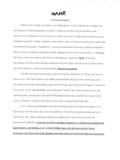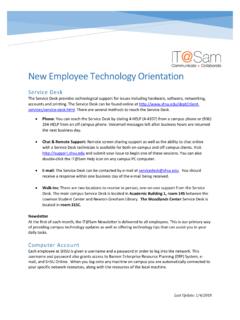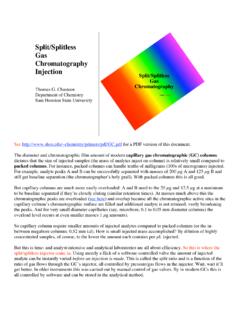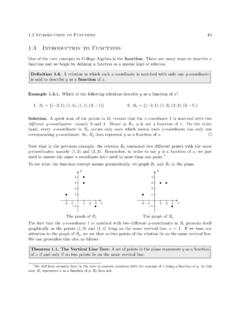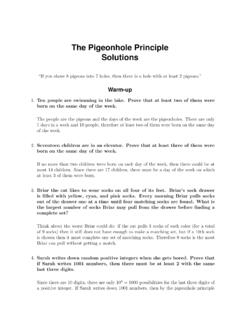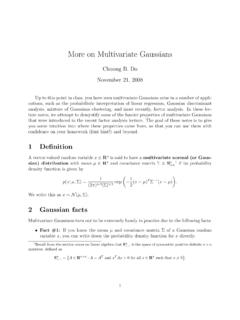Transcription of 6.2 Properties of Logarithms - Sam Houston State University
1 Properties of Properties of LogarithmsIn Section , we introduced the logarithmic functions as inverses of exponential functions anddiscussed a few of their functional Properties from that perspective. In this section, we explorethe algebraic Properties of Logarithms . Historically, these have played a huge role in the scientificdevelopment of our society since, among other things, they were used to develop analog computingdevices called slide ruleswhich enabled scientists and engineers to perform accurate calculationsleading to such things as space travel and the moon landing. As we shall see shortly, logs inheritanalogs of all of the Properties of exponents you learned in Elementary and Intermediate first extract two Properties from Theorem to remind us of the definition of a logarithm asthe inverse of an exponential (Inverse Properties of Exponential and Log Functions)Letb >0,b6= 1.
2 Ba=cif and only if logb(c) =a logb(bx) =xfor allxandblogb(x)=xfor allx >0 Next, we spell out what it means for exponential and logarithmic functions to be (One-to-one Properties of Exponential and Log Functions)Letf(x) =bxandg(x) = logb(x) whereb >0,b6= 1. Thenfandgare one-to-one. In other words: bu=bwif and only ifu=wfor all real numbersuandw. logb(u) = logb(w) if and only ifu=wfor all real numbersu >0,w > now State the algebraic Properties of exponential functions which will serve as a basis for theproperties of Logarithms . While these Properties may look identical to the ones you learned inElementary and Intermediate Algebra, they apply to real number exponents, not just rationalexponents. Note that in the theorem that follows, we are interested in the Properties of exponentialfunctions, so the basebis restricted tob >0,b6= 1.
3 An added benefit of this restriction is that iteliminates the pathologies discussed in Section when, for example, we simplified(x2/3)3/2andobtained|x|instead of what we had expected from the arithmetic in the exponents,x1= (Algebraic Properties of Exponential Functions)Letf(x) =bxbe anexponential function (b >0,b6= 1) and letuandwbe real numbers. Product Rule:f(u+w) =f(u)f(w). In other words,bu+w=bubw Quotient Rule:f(u w) =f(u)f(w). In other words,bu w=bubw Power Rule:(f(u))w=f(uw). In other words, (bu)w=buwWhile the Properties listed in Theorem are certainly believable based on similar Properties ofinteger and rational exponents, the full proofs require Calculus. To each of these Properties of438 Exponential and Logarithmic Functionsexponential functions corresponds an analogous property of logarithmic functions.
4 We list thesebelow in our next (Algebraic Properties of Logarithm Functions)Letg(x) = logb(x) be alogarithmic function (b >0,b6= 1) and letu >0 andw >0 be real numbers. Product Rule:g(uw) =g(u) +g(w). In other words, logb(uw) = logb(u) + logb(w) Quotient Rule:g(uw)=g(u) g(w). In other words, logb(uw)= logb(u) logb(w) Power Rule:g(uw) =wg(u). In other words, logb(uw) =wlogb(u)There are a couple of different ways to understand why Theorem is true. Consider the productrule: logb(uw) = logb(u) + logb(w). Leta= logb(uw),c= logb(u), andd= logb(w). Then, bydefinition,ba=uw,bc=uandbd=w. Hence,ba=uw=bcbd=bc+d, so thatba=bc+d. Bythe one-to-one property ofbx, we havea=c+d. In other words, logb(uw) = logb(u) + logb(w).The remaining Properties are proved similarly. From a purely functional approach, we can seethe Properties in Theorem as an example of how inverse functions interchange the roles ofinputs in outputs.
5 For instance, the Product Rule for exponential functions given in Theorem ,f(u+w) =f(u)f(w), says that adding inputs results in multiplying outputs. Hence, whateverf 1is, it must take the products of outputs fromfand return them to the sum of their respective the outputs fromfare the inputs tof 1and vice-versa, we have that thatf 1must takeproducts of its inputs to the sum of their respective outputs. This is precisely what the Product Rulefor Logarithmic functions states in Theorem :g(uw) =g(u) +g(w). The reader is encouraged toview the remaining Properties listed in Theorem similarly. The following examples help buildfamiliarity with these Properties . In our first example, we are asked to expand the means that we read the Properties in Theorem from left to right and rewrite productsinside the log as sums outside the log, quotients inside the log as differences outside the log, andpowers inside the log as factors outside the the following using the Properties of Logarithms and simplify.
6 Assumewhen necessary that all quantities represent positive real log2(8x)2. (10x2)3. ln(3ex)24. log3 100x2yz55. log117(x2 4) To expand log2(8x), we use the Quotient Rule identifyingu= 8 andw=xand enough, it is the exactoppositeprocess (which we will practice later) that is most useful in Algebra,the utility of expanding Logarithms becomes apparent in Properties of Logarithms439log2(8x)= log2(8) log2(x) Quotient Rule= 3 log2(x)Since 23= 8= log2(x) + 32. In the expression (10x2), we have a power (thex2) and a product. In order to use theProduct Rule, theentirequantity inside the logarithm must be raised to the same the exponent 2 applies only to thex, we first apply the Product Rule withu= 10 andw=x2. Once we get thex2by itself inside the log, we may apply the Power Rule withu=xandw= 2 and (10x2)= (10) + (x2)Product Rule= (10) + 2 (x)Power Rule= 1 + 2 (x)Since ( ) 1= 10= 2 (x) 13.
7 We have a power, quotient and product occurring in ln(3ex)2. Since the exponent 2 appliesto the entire quantity inside the logarithm, we begin with the Power Rule withu=3exandw= 2. Next, we see the Quotient Rule is applicable, withu= 3 andw=ex, so we replaceln(3ex)with the quantity ln(3) ln(ex). Since ln(3ex)is being multiplied by 2, the entirequantity ln(3) ln(ex) is multiplied by 2. Finally, we apply the Product Rule withu=eandw=x, and replace ln(ex) with the quantity ln(e) + ln(x), and simplify, keeping in mind thatthe natural log is log (3ex)2= 2 ln(3ex)Power Rule= 2 [ln(3) ln(ex)]Quotient Rule= 2 ln(3) 2 ln(ex)= 2 ln(3) 2 [ln(e) + ln(x)]Product Rule= 2 ln(3) 2 ln(e) 2 ln(x)= 2 ln(3) 2 2 ln(x)Sincee1=e= 2 ln(x) + 2 ln(3) 24. In Theorem , there is no mention of how to deal with radicals.
8 However, thinking back toDefinition , we can rewrite the cube root as a13exponent. We begin by using the Power440 Exponential and Logarithmic FunctionsRule2, and we keep in mind that the common log is log base 100x2yz5= log(100x2yz5)1/3=13log(100x2yz5)Power Rule=13[log(100x2) log(yz5)]Quotient Rule=13log(100x2) 13log(yz5)=13[log(100) + log(x2)] 13[log(y) + log(z5)]Product Rule=13log(100) +13log(x2) 13log(y) 13log(z5)=13log(100) +23log(x) 13log(y) 53log(z)Power Rule=23+23log(x) 13log(y) 53log(z)Since 102= 100=23log(x) 13log(y) 53log(z) +235. At first it seems as if we have no means of simplifying log117(x2 4), since none of theproperties of logs addresses the issue of expanding a differenceinsidethe logarithm. However,we may factorx2 4 = (x+ 2)(x 2) thereby introducing a product which gives us licenseto use the Product (x2 4)= log117[(x+ 2)(x 2)]Factor= log117(x+ 2) + log117(x 2) Product RuleA couple of remarks about Example are in order.
9 First, while not explicitly stated in the aboveexample, a general rule of thumb to determine which log property to apply first to a complicatedproblem is reverse order of operations. For example, if we were to substitute a number forxintothe expression (10x2), we would first square thex, then multiply by 10. The last step is themultiplication, which tells us the first log property to apply is the Product Rule. In a multi-stepproblem, this rule can give the required guidance on which log property to apply at each reader is encouraged to look through the solutions to Example to see this rule in , while we were instructed to assume when necessary that all quantities represented positivereal numbers, the authors would be committing a sin of omission if we failed to point out that, forinstance, the functionsf(x) = log117(x2 4)andg(x) = log117(x+ 2) + log117(x 2) have differentdomains, and, hence, are different functions.
10 We leave it to the reader to verify the domain offis ( , 2) (2, ) whereas the domain ofgis (2, ). In general, when using log Properties to2At this point in the text, the reader is encouraged to carefully read through each step and think of which quantityis playing the role ofuand which is playing the role ofwas we apply each Properties of Logarithms441expand a logarithm, we may very well be restricting the domain as we do so. One last commentbefore we move to reassembling logs from their various bits and pieces. The authors are well awareof the propensity for some students to become overexcited and invent their own Properties of logslike log117(x2 4)= log117(x2) log117(4), which simply isn t true, in general. The unwritten3property of Logarithms is that if it isn t written in a textbook, it probably isn t the Properties of Logarithms to write the following as a single log3(x 1) log3(x+ 1)2.
